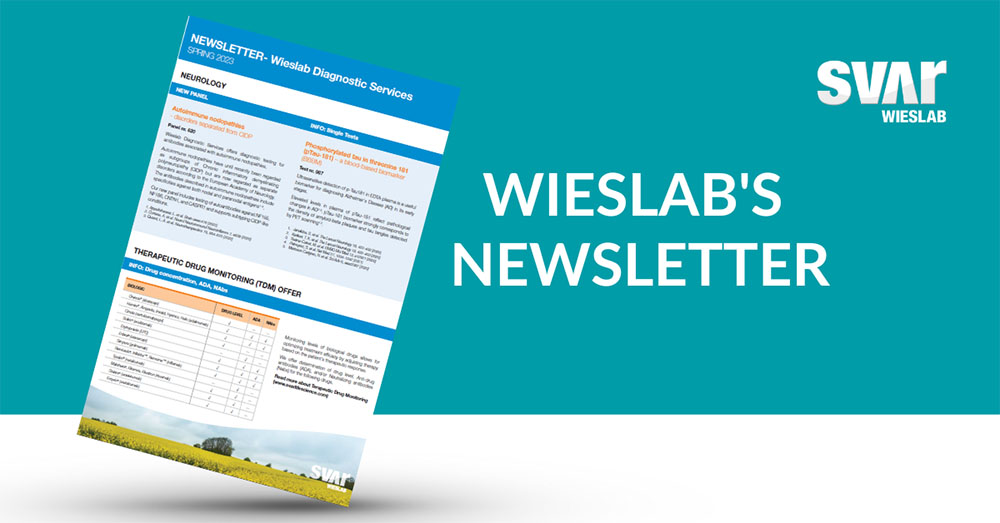- Other Products
- CCP
Wieslab's Spring 2023 Newsletter presents the latest addition to our Neurology portfolio - a new panel for supporting the diagnosis of Autoimmune nodopathies - disorders separated from CIDP - according to the European Academy.
The letter also includes information about updates to our Autoimmune portfolio, relevant Scientific Highlights related to tests, and updates to our Diagnostic Test Portfolio.
Get the latest news from Wieslab Diagnostic Services. Find out about our tests and learn about new and exciting research within the fields of neurology and autoimmunity.
Click here to sign up for future Newsletters and get them delivered electronically.


Wieslab's Spring 2023 Newsletter presents the latest addition to our Neurology portfolio - a new panel for supporting the diagnosis of Autoimmune nodopathies - disorders separated from CIDP - according to the European Academy.
The letter also includes information about updates to our Autoimmune portfolio, relevant Scientific Highlights related to tests, and updates to our Diagnostic Test Portfolio.
Get the latest news from Wieslab Diagnostic Services. Find out about our tests and learn about new and exciting research within the fields of neurology and autoimmunity.
Click here to sign up for future Newsletters and get them delivered electronically.
Wieslab Diagnostic Services offers diagnostic testing for antibodies associated with autoimmune nodopathies.
Autoimmune nodopathies have until recently been regarded as subgroups of Chronic inflammatory demyelinating polyneuropathy (CIDP) but are now regarded as separate disorders according to the European Academy of Neurology. The antibodies described in autoimmune nodopathies include specificities against both nodal and paranodal antigens1-3.
Our new panel supports subtyping CIDP-like conditions. The new panel includes testing of autoantibodies against:
> Download Neurology Request Form
1. Appeltshauser, L. et al. Anti-pan-neurofascin antibodies induce subclass-related complement activation and nodo-paranodal damage. Brain awac418 (2022) doi:10.1093/brain/awac418.
Ultrasensitive detection of p-Tau181 in EDTA-plasma is a useful biomarker for diagnosing Alzheimer's Disease (AD) in its early stages. pTau-181 biomarker strongly corresponds to the density of amyloid-β plaques and tau tangles detected by PET scanning 1,2. Elevated levels in plasma of pTau-181 reflect pathological changes in AD2–5.
.png?width=1200&height=628&name=LinkedIn%20Wieslab%20Diagnostics%201200x628px%20(13).png)
The test can still be ordered as a routine or urgent test with results within 48h (during office hours).
GBM antibodies are diagnostic markers for anti-GBM disease (Goodpasture syndrome). Anti-GBM antibodies comprise all IgG subclasses, but usually, IgG1 predominates.
The isolated presence of anti-GBM of the IgG4 subclass has been reported in cases with severe lung disease (with or without mild kidney damage)1-3.
1. Boomsma, M. M. et al. Prediction of relapses in Wegener’s granulomatosis by measurement of antineutrophil cytoplasmic antibody levels: A prospective study. Arthritis & Rheumatism 43, 2025–2033 (2000).
2. Segelmark, M. & Wieslander, J. IgG subclasses of antineutrophil cytoplasm autoantibodies (ANCA). Nephrology Dialysis Transplantation 8, 696–702 (1993).
3. Segelmark, M., Butkowski, R. & Wieslander, J. Antigen Restriction and IgG Subclasses Among Anti-GBM Autoantibodies. Nephrology Dialysis Transplantation 5, 991–996 (1990).
Monitoring levels of biological drugs allows for optimizing treatment efficacy by adjusting therapy based on the patient's therapeutic response.
This report by the Encephalitis Society highlights the global incidence, morbidity, and mortality of encephalitis, as well as the surveillance systems, diagnostics, treatments, and support available worldwide. The report suggests that the number of people affected by encephalitis each year is likely between 500,000 and 2,000,000, which is more than current estimates.
Furthermore, there are barriers to implementing diagnostics tests and treatments due to a lack of test availability and limited awareness among clinicians. This report aims to initiate a dialogue with key stakeholders who can influence many of the identified areas.
.png?width=1200&height=627&name=_Awareness%20Days%202023%20(9).png)
The Complement system plays an important role in immune defenses and tissue remodeling. In addition, it has an important pathophysiological role in several autoimmune neurological diseases. Complement mediates the actions of pathogenic autoantibodies in Myasthenia Gravis and Neuromyelitis Optica spectrum disorders, as well as diseases in the peripheral nervous system such as variants of Guillain–Barré syndrome, Autoimmune nodopathies (formerly described as a subtype of CIDP), disorders of the neuromuscular junction, Lambert-Eaton myasthenic syndrome, Dermatomyositis, and Necrotizing autoimmune myositis. Activation by the Complement system has also been reported in other neurodegenerative diseases affecting the central nervous system, such as Alzheimer’s, Amyotrophic lateral sclerosis, Autoimmune Encephalitis, and Multiple Sclerosis.
.png?width=1200&height=627&name=_Awareness%20Days%202022%20(4).png)
The Kidney Disease Improving Global Outcomes (KDIGO) 2021 includes an updated Clinical Practice Guideline for the Management of Glomerular Diseases. This guideline is the first to address the subtype of complement-mediated diseases. Key takeaways include that while kidney biopsy is considered the gold standard for diagnosis, kidney biopsy is not required to diagnose membranous nephropathy (MN) in a patient with nephrotic syndrome and a positive PLA2R antibody test. THSD7Aab test may be applied as an auxiliary non-invasive diagnostic method for PLA2R-negative MN. Patients with MN should be evaluated for associated conditions, regardless of whether anti-PLA2R antibodies and anti-THSD7A antibodies are present or absent.
.png?width=2048&height=1365&name=Untitled%20design%20(4).png)
YOUR EXPERT COMPANION FROM SAMPLE PREPARATION TO ANALYSIS RESULTS
In the app, you will be able to access information about the test portfolio and find practical information about pre-analytical sample handling and shipping.
We continuously will improve and expand the App, we are happy for your feedback about the function and its content.
.png)
Is the test you are looking for not on our Request Forms? Or are you looking for a partner for testing within a clinical trial or project? Take advantage of our expertise, flexible solutions, and exceptional customer service. Contact us today!